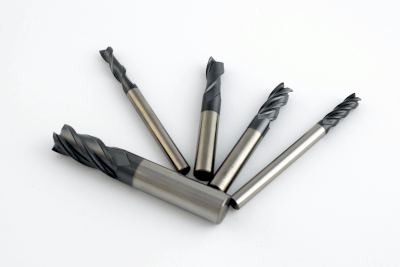What Is a Carbide End Mill?

Carbide end mills are mainly used on milling machines and drilling machines. They are primarily used to cut hard materials or materials that are difficult to machine. One of the characteristics of cemented carbide is its extreme hardness.
Tungsten carbide is an alloy made by sintering hard metal carbide powder with iron-based metal powder. Various shapes of cutting edges are available, but two-flute and four-flute spiral shapes are commonly used.
Uses of Carbide End Mills
Carbide end mills have advantages and disadvantages that should be considered:
- Advantages: Compared to HSS, the extreme hardness of carbide end mills enables high-speed cutting, reducing machining time. Additionally, their inflexible and rigid nature prevents bending and shaft expansion, ensuring precise machining.
- Disadvantages: Carbide end mills are less resistant to strength loss than HSS, which can lead to blade surface defects, among other issues.
Principles of Carbide End Mills
Carbide end mills are used to cut materials that are difficult to machine. The “cemented carbide” in carbide end mills is an alloy made by sintering very hard metallic carbide powder with iron-based metal powder. It exhibits extreme hardness, with a longitudinal modulus of elasticity three times that of iron and an indentation hardness of approximately 90.
Carbide end mills are harder than HSS, the base material, allowing for high-speed cutting, and their inflexible and rigid nature makes them suitable for precision cutting. To use them correctly, it is essential to determine the appropriate machining process based on factors like the diameter and type of the carbide end mill and the material to be cut and machined.
Re-coating and polishing can extend the life of carbide end mills, making them a cost-effective choice despite the higher initial cost compared to HSS. Each piece may be more expensive, but the extended tool life results in lower overall costs.
Carbide End Mill Material
Carbide end mills are cutting tools requiring high hardness and durability. Therefore, the material of cemented carbide end mills is a cemented carbide alloy consisting of extremely hard tungsten carbide (WC) fine particles bonded with cobalt (Co), which is both flexible and hard.
In the manufacturing process, tungsten carbide and cobalt powders are uniformly mixed in a powder mixer, then pressed into the shape of an end mill using a molding die. After that, they are sintered at a high temperature of 1300℃ or higher and completed by hot hydrostatic pressing (HIP) to remove internal defects such as gaps between the powders.
To further enhance wear and heat resistance, hard film coatings like titanium nitride (TiN) and titanium carbide (TiCN) are applied, extending service life. After a certain period of use, the coating thickness decreases, affecting its performance.
Hardness of Carbide End Mills
The hardness of carbide end mills depends on the amount of tungsten carbide and the particle size. A larger amount of tungsten carbide and smaller particle size result in higher hardness but increased brittleness, increasing the risk of chipping and cracking.
Hardness ranges from 900 HV to 1850 HV on the Vickers hardness scale, significantly higher than the maximum value of hardened steel at approximately 860 HV. This wide range allows for hardness selection based on the workpiece properties. Additionally, coating affects not only surface hardness but also heat resistance and chip evacuation properties, necessitating comprehensive judgment based on the carbide end mill’s inherent hardness.